|
The Importance of Breast
Self-Examination
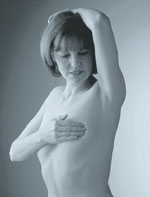 Regularly examining her own
breasts allows a woman to become familiar with how her breasts normally look and
feel and can help her more readily detect any changes that may occur. Many women
naturally have some lumpiness and asymmetry (differences between the right and
left breast). The key to the breast self-exam is to learn how to find changes
in the breasts that persist over time. Regularly examining her own
breasts allows a woman to become familiar with how her breasts normally look and
feel and can help her more readily detect any changes that may occur. Many women
naturally have some lumpiness and asymmetry (differences between the right and
left breast). The key to the breast self-exam is to learn how to find changes
in the breasts that persist over time.
While most women are aware of
monthly breast self-examination, many still do not know how to perform it
properly. Performing BSE incorrectly can be almost as bad as not doing the exam
at all since it can give women a false sense of security. After reading these
sections on BSE, women should discuss any questions they might have about BSE
techniques with their physicians and ask him or her to demonstrate how to
perform BSE during the clinical breast exam portion of the physical exam.
The Best Time to
Perform Breast Self-Examination
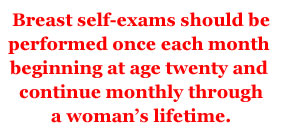 Menstruating women:
Hormonal changes due to the menstrual cycle may make the breasts more lumpy or
swollen. Women who are menstruating should perform breast self-exam from a few
days to about a week after menstruation (period) has ended, when breasts are
usually less tender or swollen. Menstruating women:
Hormonal changes due to the menstrual cycle may make the breasts more lumpy or
swollen. Women who are menstruating should perform breast self-exam from a few
days to about a week after menstruation (period) has ended, when breasts are
usually less tender or swollen.
Women who are no longer
menstruating: should do their BSE on the same day every month. Try to pick a
day that is easy to remember, such as the first or fifteenth of every month, and
make that the day each month for breast self-exam.
Women using oral
contraceptives: are encouraged to do their BSE each month on the day they
begin a new package of pills.
Breast Changes and Warning
Signs To Watch for During Breast Self-Exam:
- Any new lump or hard knot found in the breast or
armpit
- Any lump or thickening that does not shrink or
lessen after your next period
- Any change in the size, shape or symmetry of your
breast
- A thickening or swelling of the breast
- Any dimpling, puckering or indention in the breast
- Dimpling, skin irritation or other change in the
breast skin or nipple
- Redness or scaliness of the nipple or breast skin
- Nipple discharge (fluid coming from your nipples
other than breast milk), particularly if the discharge is bloody, clear and
sticky, dark or occurs without squeezing your nipple
- Nipple tenderness or pain
- Nipple retraction: turning or drawing inward or
pointing in a new direction
- Any breast change that may be cause for concern
If any of these changes are
noted, women should see their physicians as soon as possible for clinical
evaluation. However, in the majority of cases (80%), breast lumps and changes
are not cancer. Women should not allow their fear of breast cancer keep them
from telling their physician or healthcare provider about a lump or change they
have found.
Women with Normally Lumpy
Breasts Should Also Perform BSE
Even if a woman has normally
lumpy breasts (typically called fibrocystic breasts), she can still learn the
usual pattern of lumps and then point out new or unusual lumps to her physician.
While lumpy breasts or breasts with benign (non-cancerous) masses or cysts can
be more difficult to examine, monthly breast self-exams are still critical. In
fact, without knowledgeable direction from the patient, it may be more difficult
for a physician to differentiate between a new mass and a stable lump. If a
woman’s breasts are normally lumpy, she should note how many separate lumps she
feels and their corresponding locations when performing self-exams. Then, during
subsequent exams, she should check for any changes, particularly an increase in
the size of lumps that persist after her period. Any changes should be reported
to a physician or healthcare provider.
Breast Examination During
and After Pregnancy Is Critical
Women should continue monthly
breast self-examination during pregnancy. Clinical breast examination by a
healthcare professional should also be made on a monthly basis during
pregnancy. It is especially important that clinical breast exam be performed
during the first doctor visit of the pregnancy, before the breasts go through
significant physiologic changes. Some changes or lumps are more difficult to
evaluate once the breasts have enlarged and become more nodular. The main
problem with breast cancer during pregnancy is a delay in diagnosis that results
in women being diagnosed with breast cancer at a later, more advanced stage.
Vigilant, monthly breast self-examination during pregnancy and afterwards during
breast-feeding can help prevent delayed diagnosis of breast cancer and enables
optimal treatment.
Normal Breast Anatomy and
Non-Cancerous Lumps
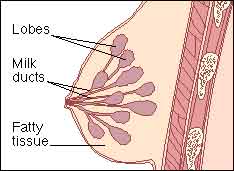 The
breast is made up of various anatomic structures including skin, fat, milk
glands or lobules, milk ducts, and connective tissue. Breast milk is produced by
the glands during lactation (breast-feeding) and carried through the ducts to
the nipple. Underneath the breast are the pectoral muscles in the chest and the
ribs. A web of lymph canals also feeds the breast. Together with lymph nodes,
the lymph system helps filter infection and disease from the body. In addition to this normal
breast anatomy, there may be masses present such as cysts (packets of fluid)
and are not cause for
concern: The
breast is made up of various anatomic structures including skin, fat, milk
glands or lobules, milk ducts, and connective tissue. Breast milk is produced by
the glands during lactation (breast-feeding) and carried through the ducts to
the nipple. Underneath the breast are the pectoral muscles in the chest and the
ribs. A web of lymph canals also feeds the breast. Together with lymph nodes,
the lymph system helps filter infection and disease from the body. In addition to this normal
breast anatomy, there may be masses present such as cysts (packets of fluid)
and are not cause for
concern:
- Normal, non-cancerous lumps such as cysts are
usually soft, smooth and moveable
- Suspicious lumps are usually firm, irregular in
shape and fixed in place
If something that seems unusual
is felt in one breast, women should feel for it in the other breast. If the area
is found in both breasts, it is probably normal breast anatomy
Monthly breast self-examination
includes both looking and feeling over the entire breast and chest
area. The steps can be performed in any order, but each step is important. Women
should use the pads, not the tips, of the three middle fingers when performing
BSE. The time required to perform the exam varies with the size and features of
a woman's breasts but usually only takes about 15 to 20 minutes each month.
Women should be sure to examine the breasts in the same manner each month, check
the entire breast and armpit area, and remember how the breasts feel from month
to month. Some women prefer to keep a small diary of their monthly breast
self-exams.
Women should use three
different patterns when examining the breasts each month:

- Vertical or "up and down" pattern (or "squares")
covering the entire breast.
- Spiral or ring pattern, making concentric rings that
tighten in a spiral, starting on the outer edges of the breast and ending
around the nipple.
- Wedge patterns in and out (or "quadrants").
Women should use three
levels of pressure (light, medium, and firm) and small "massaging" circles when
palpating the breast using the patterns described above. Women should not lift
the fingers while feeling the breasts to ensure that no area is missed.
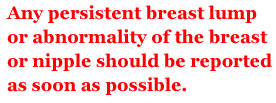
Women should perform BSE when
they can be in a private place that is free from disturbances, so they may
concentrate fully on the examination. BSE should be performed in a warm room or
during a warm shower so that the breast tissue is relaxed and easier to examine.
Cold air or cold water causes the breasts and nipples to contract and may make
examining the breasts more difficult.
Some women prefer to use a
small amount of baby powder or talcum powder on the skin of their breasts to
help reduce friction and allow the fingers to move more easily over the skin. In
addition to performing BSE in front of a mirror, some women also like to do the
standing portion of breast self-exam while taking a warm shower. Soapy fingers
reduce friction and allow some breast changes to be more easily recognized.
Areas to
Examine with Particular Care
It is important to thoroughly
examine the entire area of the breast every month:
►Outside: armpit to collar bone, and below the breast
►Middle: the breast itself
►Inside: the nipple area
However, cancerous tumours are more
likely to be found in some parts of the breast than in others. Approximately
half of all breast cancers occur in the
upper, outer region of the breast toward
the armpit. Some physicians refer to this upper outer region as the "tail" of
the breast and encourage women to examine it with great care.
Approximate
percentage of breast cancers found in each area: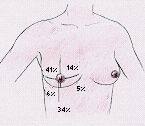
◊
41% in the upper, outer quadrant
◊
14% in the upper, inner quadrant
◊
5% in the lower, inner quadrant
◊
6% in the lower, outer quadrant
◊
34% in the area behind the nipple
BSE
Method While Standing in Front of a Mirror
Because the upright position
can make it easier to check the upper and outer portions of the breasts and
armpit, breast self-examination should be performed standing up in addition to
lying down. Looking (inspection) should take place in front of a mirror in a
well-lit area. A tall dressing mirror is often best. While standing in front of
a mirror, undress down to the waist.
 |
Place the arms at the
sides. Check the breasts for any changes in size, shape or position,
dimpling or puckering of the skin, pushed-in or misshapen nipples, other
changes in the nipple, redness, swelling or other irregularities. Then,
repeat this process with the hands on the hips, pressing firmly to flex the
chest (pectoral muscles). Bend forward with the hands on the hips and note
any irregularities. |
 |
Raise the arms overhead or
put the hands behind the head. Turn to each side to check the breasts in
profile. Note any changes in symmetry between the right and left
breast. Remember, it is often normal for women to have one breast that is
larger or a different shape than the other. |
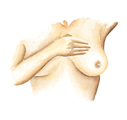 |
Examine each breast
separately and feel for any new lumps, changes, or irregularities. Use the
pads of the fingers, not the tips, and practice the patterns of examination
described in the above section (up and down line, spiral, wedge pattern).
The nipple should also be examined during this time. First, squeeze the
nipple and check for any discharge Then push the nipple deep into the hollow
beneath it. Note any unusual resistance, hardness or lump beneath the
nipple. |
During the standing portion of the exam, the
lymph nodes in each
armpit and surrounding areas under the arm should be carefully examined. Lymph
nodes are normally about the size of kidney beans. Sometimes the lymph nodes may
be enlarged by a non-cancerous infection. Occasionally, lymph node enlargement
may be caused by a cancerous process. As with any breast or nipple changes,
women should report any lymph node changes or enlargement to their physicians.
BSE Method While Lying Down
In addition to standing, breast self-examination should
also be performed while lying down. Women should use the pattern of examination
described in the above section and should ask their physicians if they have
questions about performing BSE.
 |
Lie down with a pillow or
folded towel under the right shoulder and place the right arm behind the
head. Check the entire breast and armpit area using the pads of the first
three middle fingers on the left hand to feel for lumps, changes, or
irregularities in the right breast. Press firmly enough to know how the
breast feels. A firm ridge in the lower curve of each breast is normal. The
exam should then be repeated on the left breast, using the finger pads of
the right hand (the pillow or folded towel should also be moved under the
left shoulder at this time). |
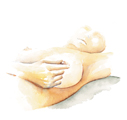 While
performing BSE lying down, the nipple should also be checked for any changes.
After making an initial examination, gently squeeze the nipple to check for any
discharge of fluid. Note any changes in appearance, discharge (including the
colour and whether the discharge occurs spontaneously or by squeezing), or
cracking. While
performing BSE lying down, the nipple should also be checked for any changes.
After making an initial examination, gently squeeze the nipple to check for any
discharge of fluid. Note any changes in appearance, discharge (including the
colour and whether the discharge occurs spontaneously or by squeezing), or
cracking.
Nipple fluid that is green or yellow is usually normal.
Nipple fluid that is bloody, dark or clear and sticky is considered abnormal
(although most suspicious nipple discharges are found to be caused by
non-cancerous conditions such as
papillomas). In
approximately 10% of all cases, nipple discharge is due to a cancerous lesion.
In women less than 30 years of age, less than 10% of nipple discharge is due to
cancer. Nevertheless, any persistent nipple discharge should be reported to a
physician for clinical evaluation.
BSE Method While in the Shower
Many women find that performing breast self-examination
in the shower in addition to standing in front of a mirror and lying down is
helpful because the skin can be lubricated by soap. Some breast changes can be
felt more easily when the skin is wet and soapy.
 |
Raise the right arm above
the head and place the right hand behind the head. Using the left hand,
examine the right breast using the methods described in the above sections.
Feel the breast with the pads of the index and middle fingers, moving in
increasingly smaller circles from the outside inward. Compress gently,
feeling for lumps. When circling the nipple, look for changes or discharge.
Repeat the exam with the left breast using the right hand. Make sure to
examine the area adjacent to the breast and below the armpit (this area
contains breast tissue and lymph nodes). |
|



